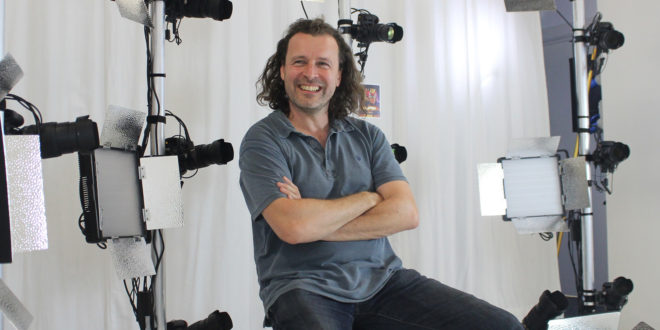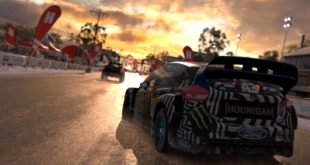Rebellion is a company full of unique characters that has spent the last 25 years pushing technological boundaries.
Take the company’s head of art, Chris Payton. His desk is littered with Playmobil. Three-inch tall figurines line his monitor, taller ornaments reach out across the workspace. Payton says he knew his desk was becoming a shrine to the plastic toys after he installed the train set.
A button on his desk sends a train bursting out from behind his monitor, rolling back past the computer, vanishing behind a figure of Sniper Elite hero Karl Fairburne.
This is family. Or as close to a family as you can be while still ensuring you get video games out of the door. Speaking to several veterans of the company, Rebellion’s internal motto seems to be to push the envelope, to take on technical challenges and emerge victorious.
Jason Kingsley, CEO and creative director of Rebellion says that the company was born out of freelance game work that he and his brother Chris, a co-founder and the company’s CTO, were doing alongside their PhDs.
“We were doing more and more computer game stuff,” says Jason Kingsley. “But we also ended up doing quite a lot of management, because nobody else in the team was doing it. So we ended up managing projects, and trying to coordinate things a little bit, as well as our freelance tasks and we weren’t getting paid for it. “
So the brothers decided to found Rebellion together and go into business for themselves.
Rebellion’s first project was the demo for a dragon flying game that pitched dragons against Viking longships. The Kingsley brothers took the game to Atari’s office in Slough.
“Atari was a shadow of its former self,” Kingsley recalls. “It had huge offices with amazing brown round Hessian wallpaper that was very faded. We went through one empty room after another to finally get to people’s offices. It was amazing. It was like something out of an apocalyptic scenario.”
The game was shown to a few people, including the CEO of Atari. “He said: ‘Oh, this will be brilliant for our new Atari Jaguar console’,” Kingsley explains. “The Atari people went: ‘What new console?’ The first time anybody in Europe had heard of the Atari Jaguar was when their CEO told people in our meeting that this would be good for that console.”
The dragon versus longship battler wasn’t commissioned, but Atari had the license for an Alien vs Predator game, and they wanted Rebellion to make it for them.
"We’ve always wanted to make games that we want to play."
This was the team’s first game developed in-house and required Rebellion to hire staff and rent out an office. Kingsley states that working with such an established license as their first game was a “very respectful” process, that Rebellion started out with “complete confidence.” Atari was expecting a side-scrolling 2D beat-em-up, but Rebellion won the firm over on an “into the screen 3D thing” that ended up being one of the earliest first-person shooters.
Kingsley describes the Atari Jaguar classic as “truly innovative,” with the team pulling out all the stops with several techniques that hadn’t been seen before: building and photographing models to scan into the game as texture maps, characters animated with stop motion techniques and 16-bit colour.
The gameplay had a unique quirk, too, allowing gamers to play as the villains, both predator and xenomorph. These additions resonated with gamers and Alien Vs Predator became the best selling game on the Atari Jaguar.
This success meant that when Fox decided to move into games, the firm approached Rebellion to create a new version of Alien vs Predator for the PC, one that featured full 3D, giving xenomorphs the memorable ability to skitter across the ceiling. This was a technical challenge as well as a gameplay choice: many developers of the era were saving polygons by making their ceilings less detailed than the floor because a player wasn’t likely to look at it closely. For Rebellion, every wall and ceiling were a floor. A shortcut would be impossible.
Too ambitious
“One of the problems we’ve always had at Rebellion is that we’re always too ambitious in how we create our environments,” Kingsley says with a smile that indicates he’s not too upset.
Take Sniper Elite, an FPS game about taking out soldiers of the Third Reich at long range, perhaps Rebellion’s best-known franchise in recent years.
“A sniping game means you need to be able to zoom into the distance,” Kingsley continues. “For a lot of people that don’t have sniping in their games, they don’t have to worry about distance and the number of polygons.
“We often feel that we’ve made a rod for our own backs with some of our creative decisions, but our technical team is so good that they can make the best of it and make it really work. And that’s why our games are successful, and why, I think, games like the Sniper Elite series are right up there with the best games in the world from the very expensive and very well funded big studios.”
Kingsley says that the firm is “absolutely” drawn to technical and gameplay challenges that they can try to conquer. It’s something shared by the entire company.
Everything Rebellion creates is built on its own technology, so the studio uses its own engine, and tries to avoid middleware where possible so that everything is tooled towards the game it’s been created for.
“If there’s something we need it to do, we can make the engine do that,” says Kingsley. “We don’t have to worry that ‘Oh, the engine can’t do that so we have to compromise our creative visions’.”
It’s not just in the engine tech, too. Payton, who’s been with Rebellion for a decade, and the company’s head of art for just over six years, has gone from overseeing three people to 19, but he’s also seen art in video games go through a substantial change.
“Budgets have gone up, naturally, but also what you can do in the same amount of time goes up. For example, the heads of our characters separate from the bodies,” says Payton. “There’s a little line around the neck and that’s how we can change heads. In Sniper Elite 3, it took us ten days to make a head, and that would be done by eye, essentially. We would do reference photography, we would cut and paste bits of skin, bits of eyes, things like that. This would take ten days to make it. Now, it takes us ten days to make a head by programmetry, so we’re not actually saving time, but the quality improvement is massive. All those subtleties make a face a face, and that’s what we’re really looking for.”
This is a typical example of Rebellion’s development process: Payton talks about how improvements in the workflow, new technologies and tools or even innovative solutions have come forward to reduce the requirements of games, to squeeze as much performance as possible out of consoles and PCs. Then the team comes in and uses this extra power to try to add a new feature or make things look better.
“As much as we make things a little faster, a little better in terms of performance, we’re also making battles bigger, putting in higher quality textures or creating higher fidelity shaders,” says Payton.
He adds that the Kingsleys, both Jason and Chris, are very supportive of teams taking big risks if they think there’s a payoff. Payton hints at an internal feature that a small team has been working on for months, that has now brought results that Rebellion is hoping to integrate into a new game. All very vague of course, but it shows something about Rebellion: that the studio is constantly iterating and improving on things, pushing forwards not just to keep gamers invested but also to create something the company wants to play for themselves.
This focus on bettering themselves led to the art team pulling out and reworking the rendering system between Sniper Elite 3 and its sequel, the well-received Sniper Elite 4 but it also means that, of all the projects Payton is most excited about at Rebellion, he’s hoping he’ll get another chance to go back to World War II, as he’s got unfinished business with the Nazi-killing sniper Karl Fairburne.
“I would love to make another Sniper Elite game,” he enthuses. “I think it’s an artistic thing, when you’ve been making something for a while, I think the last third of it, you’re already thinking: ‘Shit, if I do this again, I’d be doing that or I’d be doing this.”
Making games for themselves
Jason Kingsley suggests that the reason Rebellion throws itself so entirely into every technological challenge is that, fundamentally, they’re making games for themselves:
“We’ve always wanted to make computer games that we want to play. That’s the truth of it. We don’t do much in the way of analytics or analysis of what’s the next big thing in computer games, because we just like making the games we like to play.”
For a studio with such a strong drive to create its own unique visions, Kingsley describes work-for-hire as a relatively limiting prospect, and says the company
moved out of work-for-hire at a time when the market was changing.
“It was becoming more difficult to work,” he says. “The prices for projects were coming down, it was getting harder and harder to have enough people, and then you get a gap between projects and people say: ‘Have you got 100 people ready to go tomorrow?’ And you go: ‘Well how could I have thought to have 100 people sitting around for six months while you decide to do a project?’ It is a difficult thing to manage and there are still very successful people that do work-for-hire, but prices have gone back up again now so people who work-for-hire are charging much more now than they used to.”
Still, the change in the market encouraged Rebellion to transition into making their own games. Kingsley went about this in two ways, pivoting Rebellion towards creating its own titles and buying up IPs he’d worked with or wanted to work with. This led to the acquisition of several older licenses they’d worked on such as Battlezone, but also the wholesale acquisition of comics outfit 2000AD, giving the studio unlimited access to the characters and scenarios described within the comic book’s pages.
"Our mum has stopped asking when I’m going to get a proper job, at least."
Now the company is truly independent, working on its own games free of shareholders, publishers or any other commitments. Kingsley says it sometimes still doesn’t feel like a real job even after 25 years.
“Our mum has stopped asking when I’m going to get a proper job, at least. That stopped about a decade ago, but until that point she was still expecting us to get bored of this and go on to get a ‘standard’ job. Computer games creator is a new type of job, and we were among the very first wave of people to get involved in the industry.”
Video games are often viewed as a hit-based industry, but Kingsley says they’ve managed to be consistently successful over the last 25 years by being sensible with budgets and scope.
“I don’t think [games] is a hit-driven industry if you do it right. I think you can make a game for a sensible budget, and you can quite probably sell enough to get the money back to do it again. Yes, our games don’t sell 10m units on Day One, but very few games do. I’m led to believe lots of people exaggerate their numbers, because they’re public companies and they need to reassure shareholders.
“The problem comes when the game is so expensive to make, that even if it sells very, very well, it hasn’t made enough money to make it a viable business,” Kingsley says, pulling figures out of the air. “That’s the tension. If it costs you $50m to make a game and you get $49m back from selling the game, well, that’s bad business. If you can make a game for $10m and sell $15m, then you’ve made $5m profit and you can put that back into the next game.”
The portfolio approach
Rebellion’s stability, Kingsley opines, is down to its portfolio approach to games so that there’s a mix of projects of different sizes landing at different times with manageable budgets. There’s plenty of room for experiments, but the team doesn’t gamble everything on
a single game.
The company has experimented with VR with Battlezone – “a huge financial success for Rebellion,” Kingsley says, adding that Rebellion is “going to stay in VR.” The studio is also experimenting with remasters of earlier games, with a recent Rogue Trooper release doing good numbers for the company, although Kingsley says the team isn’t keen to just continue retreading old ground when there are new games to release.
New games in this case takes the form of Strange Brigade, a four player co-op shooter that channels something distinctly British in its story of four pulp-era adventures battling mythological creatures for ancient relics and profit. If it works out, it’ll be another successful IP for Rebellion. If not, the studio has several more ideas for what might come next.
Kingsley describes the portfolio approach as a desire to avoid gambling everything on one project. But, as it turns the page on its second quarter-century, the company feels like a sure bet.

 MCV/DEVELOP News, events, research and jobs from the games industry
MCV/DEVELOP News, events, research and jobs from the games industry




